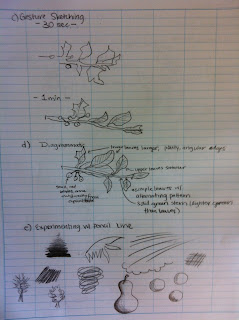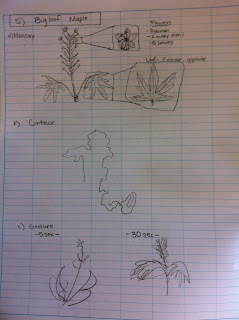Weather: cold, cloudy, interspersed rain, and a major hail storm!
Temp: 37 F
Time: 4:00pm-5:00pm
Location: Discovery Park
The weather over the weekend was a little colder than last week, close to freezing, due to a low pressure storm front on the eastern U.S. coast that was passing over the Pacific Northwest. Once again, we went out bundled in multiple layersand this time I grabbed some Ziploc bags--we knew we were definitely going to collect some specimens for more detailed field drawing later.
Upon entry into the park from the parking lot, an American Robin stood almost sentinel guarding the entrance.
 |
| "Password?" (American Robin) |
We observed the other species, including our unknown Rosaceae species, which appears to be getting closer to fruiting, as its flower petals are falling off. We are excited for the fruits to come out so it can aid in our identification! It is almost definitely non-native...
Also, I revisited the Alaskan Yellow Cedar (Nootka cypress) and the nearby thistle with the "larvae" on it to see if there had been any development in the larvae development. However, on a more careful observation, I matched the small, cone-like structures at the tips of the leaves of the tree...
To the "larvae" eggs resting on the milk thistle directly below...
Oops! I guess it wasn't larvae after all! In fact, they are actually the pollen-bearing structures. Alaskan cedar is monoecious, which means that it has both male and female parts (this is true for all trees with cones). The tiny inconspicuous yellow or reddish male pollen-bearing strobili and the green female cones are born on the tips of branchlets.
We had to look a little harder, but we did find some new plant species on this trip!
 | ||
| Common yarrow |
 |
| Cherry laurel |
 | |
| Rowan tree, sometimes mistaken for Mountain Ash |
 |
| The leaves almost look as if they were cookie-cuttered. Plump with deep serrated edges and central vein. |
 |
| Elderberry, also identified at Ravenna Park (see iNaturalist) Note distinctive 5 compound leaves in opposite pinnate pattern. |
 | ||
| Thimbleberry, also identified at Ravenna Park |
 |
| Pointed growth tips of the Douglas fir |
 | |
| Cones forming on the Douglas fir! |
Once again, the birds were elusive--it seemed the brazen robin from before was an exception. A variety could be heard. Some birds seemed to stay in groups and would be seen quickly flitting between one thick evergreen tree and another; usually only a bird or two would fly at a time every few seconds. Likely a well-rehearsed defense mechanism.
However, other small birds could be seen on their own foraging and calling from within shrubs and small trees low to the ground. They would jump around on the branches in some kind of searching manner. Some shrubs had little enough foliage that I could snap a quick picture!
 |
| The black-capped chickadee. If only it turned its head a little more to the left... |
 | ||
| Teeny insects beneath our feet! |
Next, we almost breezed by a new mushroom! Not really our fault though; it was probably only about 1and1/2 to 2 inches tall.
 |
| Some kind of tiny morel? |
 |
| The aftermath |
The next day, after reading some of the guide for field sketching by Claire Walker Leslie, a well-known nature artist, we attempted 6 of the different prescribed exercises:
1. Memory sketch--examine the specimen carefully, then put it away and draw as much detail as you can remember.
2. Contour--without looking at the paper, continuous trace the outline of the specimen as you follow the outline with your eyes.
3. Gesture--quick sketches. We limited out sketches to 5 seconds, 30 seconds, and then 1 minute.
4. Diagrammatic--No more than 5 minutes drawing the plant, focusing on and labeling the distinguishing features.
5. Experimenting with pencil line.
6. Study--Finally, spending about 15-20 minutes creating a detailed, labeled drawing.
See my results below, for European Holly, our unknown Rosaceae, Alaskan Yellow Cedar, Elderberry, and Bigleaf Maple.
From this exercise, I feel I learned to be a much better observer of plants for field identification purposes. In order to make an accurate drawing, I eventually had to create a mental checklist of all the tiny features I needed to look for--all the parts of the flower, how the buds and growths are connected, and the different types of leaf patterns and organization.
More next week!













No comments:
Post a Comment